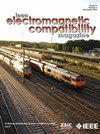基于印刷传输线导体截面的无源互调模型
IF 2
3区 计算机科学
Q3 ENGINEERING, ELECTRICAL & ELECTRONIC
IEEE Transactions on Electromagnetic Compatibility
Pub Date : 2024-12-16
DOI:10.1109/TEMC.2024.3511254
引用次数: 0
摘要
当形状复杂的传输线截面影响导体内部电磁场分布时,有必要将数值方法与导体截面形状相结合,计算由电流分布不均匀引起的电热无源互调(ET PIM)电流密度。因此,为了分析TL截面几何形状对ET PIM的影响,推导了考虑导体截面几何形状和传输损耗的TL ET PIM模型。在模型中,定义了修正梯度模型来表征非线性电导率和导体损耗。同时,设计了微带线、网状微带线和平行板波导的PIM测量实验,比较了ET PIM3模型的数值解。最后,对横截面几何效应对ET PIM3产生的影响进行了数值分析,以解释ET PIM3测量的现象。结合实测结果,数值解表明,在高电流密度区域产生的ET PIM受截面几何形状、频率偏移和热通量的影响。本文章由计算机程序翻译,如有差异,请以英文原文为准。
Passive Intermodulation Model Based on Conductors Cross-Section for Printed Transmission Line
When the cross section of a transmission line (TL) with a complex shape affects the internal electromagnetic field distribution of the conductor, it is necessary to combine the numerical method and the cross-sectional shape of the conductor to calculate the electrothermal passive intermodulation (ET PIM) current density caused by the uneven current distribution. Therefore, to analyze the influence of TL cross-sectional geometry on ET PIM, an ET PIM model of TL considering conductor cross-sectional geometry and transmission loss is derived. In the model, the modified gradient model is defined to characterize the nonlinear conductivity and conductor loss. Meanwhile, the PIM measurement experiments of the microstrip line, meshed microstrip line and parallel plate waveguide are designed to compare numerical solutions of the ET PIM3 model. Finally, numerical analyses of cross-sectional geometry effects on ET PIM3 generation are made to explain the phenomenon of ET PIM3 measurement. Combined with the measurement results, the numerical solution shows that the ET PIM produced in the high current density region is affected by the cross-sectional geometry, frequency offset, and thermal flux.
求助全文
通过发布文献求助,成功后即可免费获取论文全文。
去求助
来源期刊
CiteScore
4.80
自引率
19.00%
发文量
235
审稿时长
2.3 months
期刊介绍:
IEEE Transactions on Electromagnetic Compatibility publishes original and significant contributions related to all disciplines of electromagnetic compatibility (EMC) and relevant methods to predict, assess and prevent electromagnetic interference (EMI) and increase device/product immunity. The scope of the publication includes, but is not limited to Electromagnetic Environments; Interference Control; EMC and EMI Modeling; High Power Electromagnetics; EMC Standards, Methods of EMC Measurements; Computational Electromagnetics and Signal and Power Integrity, as applied or directly related to Electromagnetic Compatibility problems; Transmission Lines; Electrostatic Discharge and Lightning Effects; EMC in Wireless and Optical Technologies; EMC in Printed Circuit Board and System Design.

 求助内容:
求助内容: 应助结果提醒方式:
应助结果提醒方式:


